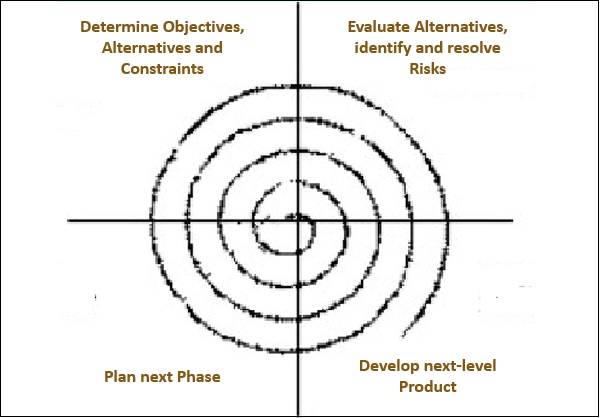
- Adaptive S/W Development Tutorial
- Adaptive S/W Development - Home
- Introduction
- SDLC Models - Evolution
- SDLC - Waterfall Model
- SDLC - Iterative Incremental Model
- Rapid Application Development
- SDLC - Spiral Model
- SDLC - Agile Methods
- Evolution
- Concepts
- Lifecycle
- Lifecycle Characteristics
- Practices
- Adaptive Management
- Useful Resources
- Quick Guide
- Useful Resources
- Discussion
SDLC - Spiral Model
Spiral model adds Risk Analysis and RAD prototyping to the Waterfall model. Each cycle involves the same sequence of steps as the Waterfall model.

Spiral model has four quadrants. Let us discuss them in detail.
Quadrant 1 - Determine objectives, alternatives and constraints
Objectives − Functionality, performance, hardware/software interface, critical success factors, etc.
Alternatives − Build, reuse, buy, sub-contract, etc.
Constraints − Cost, schedule, interface, etc.
Quadrant 2 - Evaluate alternatives, identify and resolve risks
Study alternatives relative to the objectives and constraints that are determined.
Identify risks such as lack of experience, new technology, tight schedules, etc.
Resolve the identified risks evaluating their impact on the project, identifying the needed mitigation and contingency plans and implementing them. Risks always need to be monitored.
Quadrant 3 - Develop next-level product
Typical activities include −
- Create a design
- Review design
- Develop code
- Inspect code
- Test product
Quadrant 4 - Plan next phase
Typical activities include −
- Develop project plan
- Develop configuration management plan
- Develop a test plan
- Develop an installation plan
Spiral Model – Strengths
The advantages or strengths of the Spiral method are −
- Provides early indication of the risks, without involving much cost.
- Users can view the system early because of the rapid prototyping tools.
- Critical high-risk functions are developed first.
- The design does not have to be perfect.
- Users can be closely involved in all lifecycle steps.
- Early and frequent feedback from users.
- Cumulative costs assessed frequently.
Spiral Model – Weaknesses
The disadvantages or weaknesses of the Spiral method are −
May be hard to define objectives, verifiable milestones that indicate readiness to proceed through the next iteration.
Time spent in planning, resetting objectives, doing risk analysis and prototyping may be an overhead.
Time spent for evaluating risks can be too large for small or low-risk projects.
Spiral model is complex to understand for new team members.
Risk assessment expertise is required.
Spiral may continue indefinitely.
Developers must be reassigned during non-development phase activities.
When to Use Spiral Model?
The Spiral model can be used when −
- Creation of a prototype is appropriate.
- Risk evaluation is important.
- A project is of medium to high-risk.
- Users are unsure of their needs.
- Requirements are complex.
- Product-line is new.
- Significant changes are expected during exploration.
- Long-term project commitment unwise because of potential business changes.